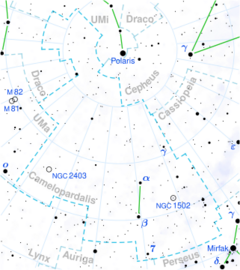Astronomy:Gamma Camelopardalis
| Observation data Equinox J2000.0]] (ICRS) | |
|---|---|
| Constellation | Camelopardalis |
| Right ascension | 03h 50m 21.50892s[1] |
| Declination | +71° 19′ 56.148″[1][2] |
| Apparent magnitude (V) | 4.66[3] + 9.07[4] |
| Characteristics | |
| Spectral type | A2 IVn[5] |
| U−B color index | +0.07[3] |
| B−V color index | +0.03[3] |
| Astrometry | |
| Radial velocity (Rv) | 0.2±2.5[6] km/s |
| Proper motion (μ) | RA: +18.17[1] mas/yr Dec.: −42.85[1] mas/yr |
| Parallax (π) | 9.09 ± 0.18[1] mas |
| Distance | 359 ± 7 ly (110 ± 2 pc) |
| Absolute magnitude (MV) | −0.62[7] |
| Details | |
| γ Cam A | |
| Mass | 2.98±0.04[8] M☉ |
| Radius | 2.5[9] R☉ |
| Luminosity | 185[8] L☉ |
| Temperature | 8,892[8] K |
| Rotational velocity (v sin i) | 205[10] km/s |
| Other designations | |
| Database references | |
| SIMBAD | data |
Gamma Camelopardalis, Latinized from γ Camelopardalis, is a suspected wide binary star[11] system in the northern circumpolar constellation of Camelopardalis. With a visual magnitude of 4.66,[3] it is faintly visible to the naked eye. Based upon an annual parallax shift of 9.09 mas as seen from Earth,[1] this star is located about 359 light years from the Sun.
The brighter primary, designated component A, is a white-hued A-type subgiant star with a stellar classification of A2 IVn.[5] It is spinning rapidly with a projected rotational velocity of 205 km/s. This is giving the star an oblate shape with an equatorial bulge that is 17% larger than the polar radius.[10] It has about three[8] times the mass of the Sun and 2.5[9] times the Sun's radius. The star is radiating 185[8] times the Sun's luminosity from its photosphere at an effective temperature of 8,892 K.[8]
The magnitude 9.07 secondary, BD+70 260, designated component C, lies at an angular separation of 106.00 arc seconds along a position angle of 85°, as of 2011. Component B is a magnitude 12.40 visual companion at a separation of 56.30 arc seconds along position angle 247°.[4]
References
- ↑ 1.0 1.1 1.2 1.3 1.4 1.5 van Leeuwen, F. (2007), "Validation of the new Hipparcos reduction", Astronomy and Astrophysics 474 (2): 653–664, doi:10.1051/0004-6361:20078357, Bibcode: 2007A&A...474..653V.
- ↑ 2.0 2.1 "gam Cam". SIMBAD. Centre de données astronomiques de Strasbourg. http://simbad.u-strasbg.fr/simbad/sim-basic?Ident=gam+Cam.
- ↑ 3.0 3.1 3.2 3.3 Johnson, H. L. et al. (1966), "UBVRIJKL photometry of the bright stars", Communications of the Lunar and Planetary Laboratory 4 (99): 99, Bibcode: 1966CoLPL...4...99J.
- ↑ 4.0 4.1 Mason, B. D. et al. (2014), "The Washington Visual Double Star Catalog", The Astronomical Journal 122 (6): 3466, doi:10.1086/323920, Bibcode: 2001AJ....122.3466M.
- ↑ 5.0 5.1 Cowley, A. et al. (April 1969), "A study of the bright A stars. I. A catalogue of spectral classifications", Astronomical Journal 74: 375–406, doi:10.1086/110819, Bibcode: 1969AJ.....74..375C.
- ↑ de Bruijne, J. H. J.; Eilers, A.-C. (October 2012), "Radial velocities for the HIPPARCOS-Gaia Hundred-Thousand-Proper-Motion project", Astronomy & Astrophysics 546: 14, doi:10.1051/0004-6361/201219219, A61, Bibcode: 2012A&A...546A..61D.
- ↑ Anderson, E.; Francis, Ch. (2012), "XHIP: An extended hipparcos compilation", Astronomy Letters 38 (5): 331, doi:10.1134/S1063773712050015, Bibcode: 2012AstL...38..331A.
- ↑ 8.0 8.1 8.2 8.3 8.4 8.5 Zorec, J.; Royer, F. (January 2012), "Rotational velocities of A-type stars. IV. Evolution of rotational velocities", Astronomy & Astrophysics 537: A120, doi:10.1051/0004-6361/201117691, Bibcode: 2012A&A...537A.120Z.
- ↑ 9.0 9.1 Pasinetti Fracassini, L. E.; Pastori, L.; Covino, S.; Pozzi, A. (2001), "Catalogue of Apparent Diameters and Absolute Radii of Stars (CADARS)", Astronomy and Astrophysics 367 (2): 521, doi:10.1051/0004-6361:20000451, Bibcode: 2001A&A...367..521P.
- ↑ 10.0 10.1 van Belle, Gerard T. (March 2012), "Interferometric observations of rapidly rotating stars", The Astronomy and Astrophysics Review 20 (1): 51, doi:10.1007/s00159-012-0051-2, Bibcode: 2012A&ARv..20...51V.
- ↑ Eggleton, P. P.; Tokovinin, A. A. (September 2008), "A catalogue of multiplicity among bright stellar systems", Monthly Notices of the Royal Astronomical Society 389 (2): 869–879, doi:10.1111/j.1365-2966.2008.13596.x, Bibcode: 2008MNRAS.389..869E.
External links
 |


